Book contents
- Frontmatter
- Contents
- WORKS BY LADY WILDE
- THE BONDAGE OF WOMAN
- GENIUS AND MARRIAGE
- SOCIAL GRACES
- VENUS VICTRIX
- SPIRITUAL AFFINITY
- SUITABILITY OF DRESS
- AMERICAN WOMEN
- THE WORLD'S NEW PHASES
- THE DESTINY OF HUMANITY
- AUSTRALIA (a Plea for Emigration)
- THE VISION OF THE VATICAN
- IRISH LEADERS AND MARTYRS
- THE POET AS TEACHER
- THE TWO ARTISTS: A SKETCH (from the Spanish)
- ‘TERTIA MORS EST’ (from the German,)
SUITABILITY OF DRESS
Published online by Cambridge University Press: 05 March 2012
- Frontmatter
- Contents
- WORKS BY LADY WILDE
- THE BONDAGE OF WOMAN
- GENIUS AND MARRIAGE
- SOCIAL GRACES
- VENUS VICTRIX
- SPIRITUAL AFFINITY
- SUITABILITY OF DRESS
- AMERICAN WOMEN
- THE WORLD'S NEW PHASES
- THE DESTINY OF HUMANITY
- AUSTRALIA (a Plea for Emigration)
- THE VISION OF THE VATICAN
- IRISH LEADERS AND MARTYRS
- THE POET AS TEACHER
- THE TWO ARTISTS: A SKETCH (from the Spanish)
- ‘TERTIA MORS EST’ (from the German,)
Summary
Nothing, in general, bewilders or tortures the female mind more than the endeavour to establish some kind of harmonic relation between the law of the fashion book and the law of life, the one being for the idler, the other for the worker. Yet with some resolute self-assertion and heroic defiance of conventional prejudice, a compromise might be effected, the result being increased comfort to the workers in life's thorny paths without even the sacrifice of beauty. Rather would a fresh beauty be added to woman by the fitness and propriety of costume, always so pleasant to the wearer, and so agreeable to the eye of the artistic spectator.
The Roman Catholic Church, that so well understands the working of the innermost wheels of our complex human nature, at once recognised the truth that dress and vocation should be in harmony, and that besides being a symbol, dress should be a help. Hence the soft, simple, shrouding robes of the holy sisterhoods, where nothing is permitted of showy material or marked delineation of form to jar upon penitent humility, or to irritate the sad and sick, the weary-hearted or worldworn but everything in the costume is grave, calm and noiseless, to soothe and lull like low music. Loud dressing, the glare of colour, the rustle of starch, the frou-frou of silk, are all such cruel discords, when mind and body are lying faint and weak and low, while the soft woollen robes that glide and float with soundless motion are entirely sympathetic and soothing.
- Type
- Chapter
- Information
- Social Studies , pp. 108 - 122Publisher: Cambridge University PressPrint publication year: 2010First published in: 1893

